
Durango Billís
Epitrochoids and Hypotrochoids
We will first look at an example of an Epitrochoid which is formed by rolling one circle around the outside of another circle. Further down this page we will look at Hypotrochoids which are formed by rolling one circle around the inside of another. All graphs on this page were generated via Microsoftís Excel.
Epitrochoids
The graph below shows an Epitrochoid that is formed when a small circle with a radius of 2 is rolled around the outside of a circle with a radius of 6. An arm with a length of 4 has one end attached to the center of the rolling circle. The path of the other end of the arm is shown in red and forms the Epitrochoid. The circumference of the stationary circle is shown in green while the path taken by the center of the rolling circle is shown in dark blue.
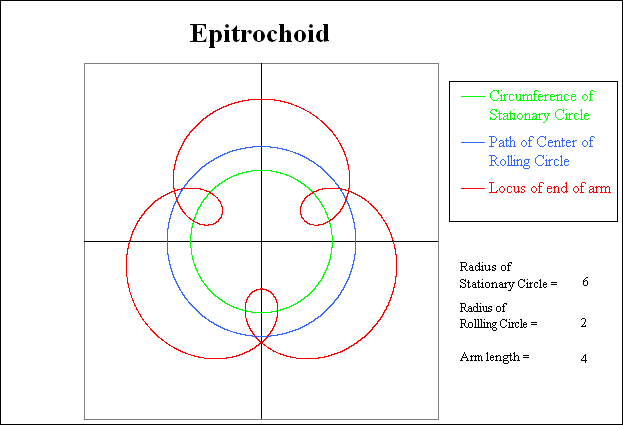
The following sequence of pictures show various stages in the generation of the Epitrochoid. In each picture, the circumference of the stationary circle is shown in green. The current position of the rolling circle is shown in light blue. The trace of the path taken by the center of the rolling circle is shown in dark blue. The current position of the arm attached to the rolling circle is shown in orange. Finally the path generated by the outer end of the arm generates the Epitrochoid, and is shown in red.
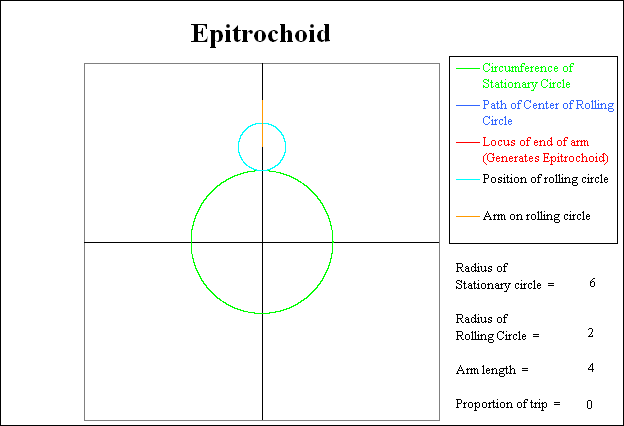
Initially the rolling circle starts at the top of the stationary circle. The orange arm is straight up and overlies part of the Y axis. There is no red or dark blue line yet as nothing has moved.
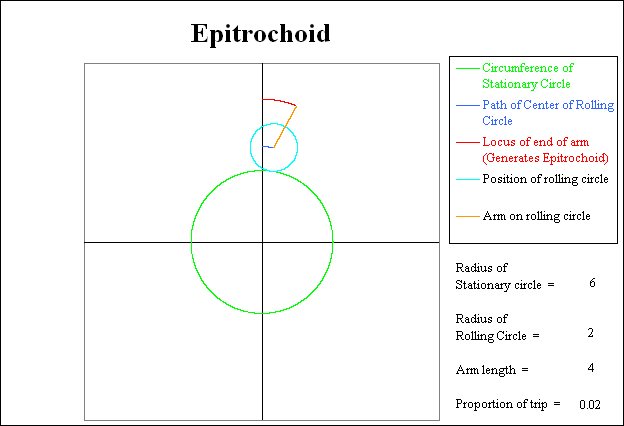
Here, the rolling circle has started its clockwise trip around the stationary circle. The dark blue line shows the path of the center of the rolling circle while the outer end of the arm is beginning to generate the Epitrochoid. At this stage the rolling circle has completed 2 % of its trip.
The following sequence of pictures show subsequent stages in the formation of the Epitrochoid. The legend in the lower right portion of each picture displays the relative progress.
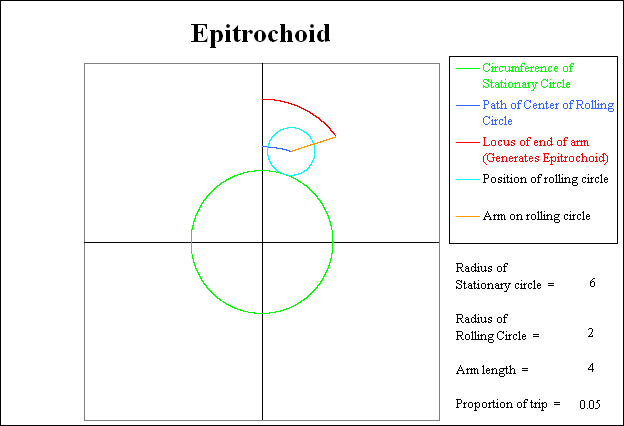
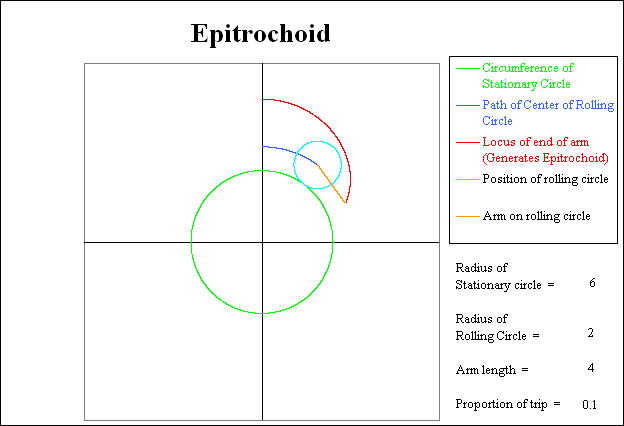
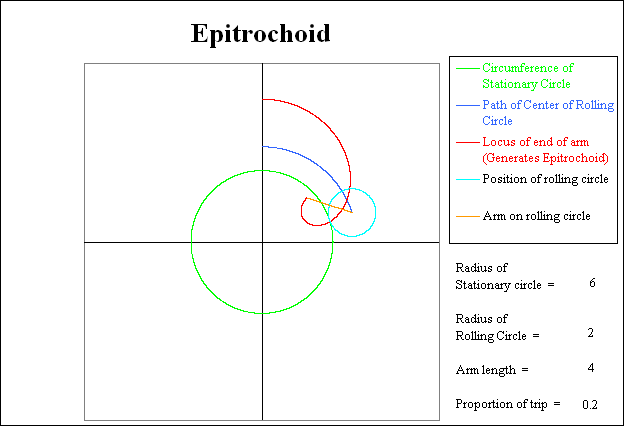
The radius of the stationary green inner circle is 6. The radius of the light blue, rolling circle is 2. Thus the rolling circle will rotate 6 / 2 = 3 times relative to the stationary circle while it is rolling around the stationary circle. Since the clockwise direction that the rolling circle is moving produces a clockwise relative rotation of the arm, the total number of revolutions of the arm relative to the coordinate system will be 3 + 1 = 4. The arm will be straight up at trip proportion locations of 0.25, 0.50, 0.75, and 1.00.
When the earth rotates around the sun a similar rotation phenomenon exists. The earth rotates ~365.25 times per year relative to the sun to produce ~365.25 days per year. However, as measured by the rest of the stars in the universe, our absolute number of rotations per year is one more: 365.25 + 1.00 = 366.25.
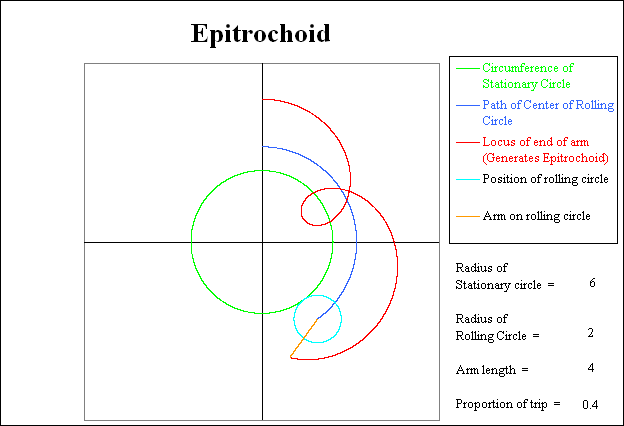
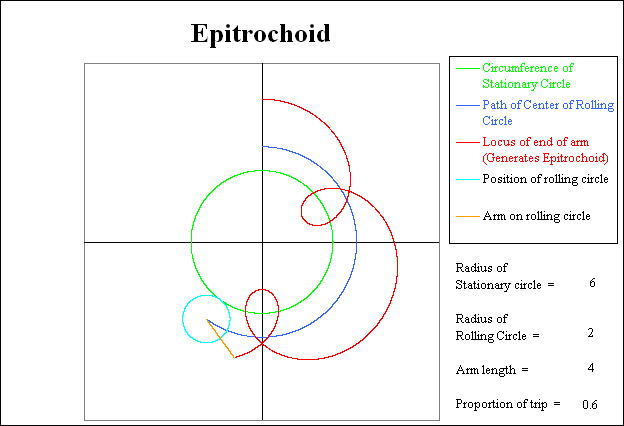
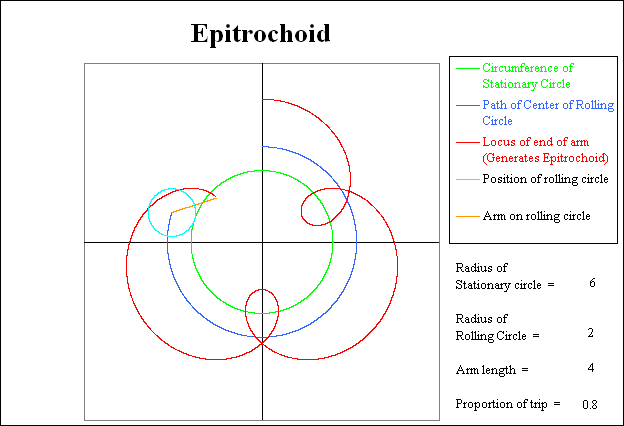
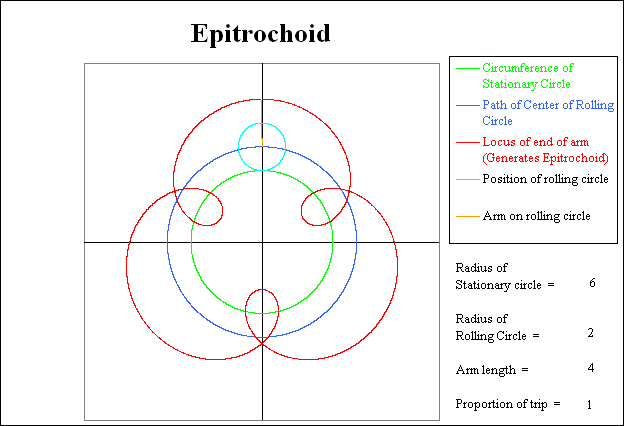
Finally after the rolling circle has completed 3 revolutions relative to the stationary circle (and completed 4 revolutions relative to the coordinate system), the rolling circle has returned to the starting position, and the Epitrochoid is complete.
While the above example displays one of the infinite number of possible Epitrochoids, slight changes in the dimensions that are used can produce other interesting patterns.
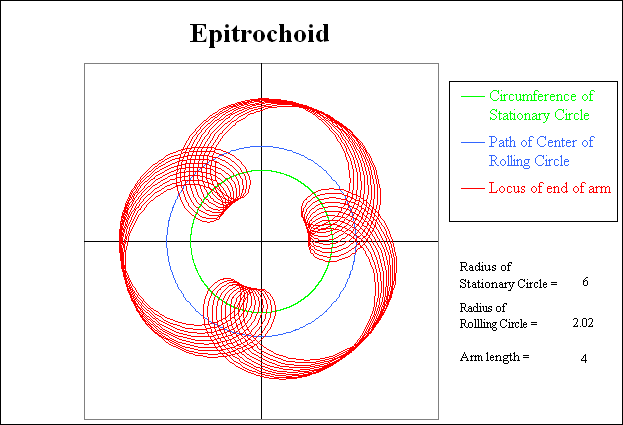
In the picture above, the radius of the rolling circle has been increased from 2.00 to 2.02. Thus the distance required to complete 3 rolling rotations around the stationary circle increases slightly from 6.00 to 6.06. The diagram shows the result of 30 rolls relative to the stationary circle. The slightly increased total distance produces a clockwise rotational precession in the resulting pattern.
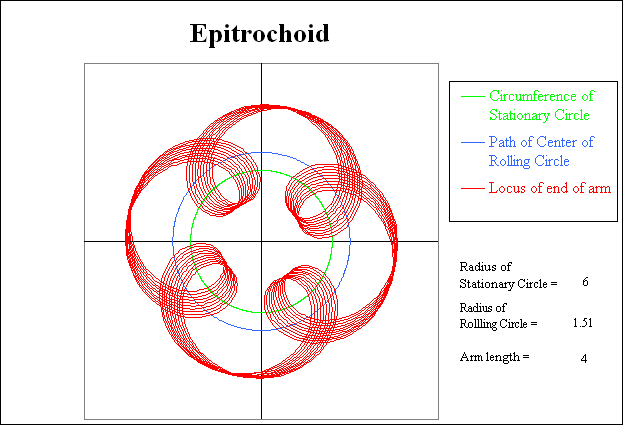
Another change in the radius of the rolling circle produces the above pattern. If the radius had been set to exactly 1.50, then a simple Epitrochoid with 4 loops would have resulted. However, by setting the radius to 1.51, another precession pattern is produced.
For additional information about Epitrochoids and the mathematics required to generate them, please see http://mathworld.wolfram.com/Epitrochoid.html
Hypotrochoids
If the circle rolls around the
inside of a stationary circle, then the result is a
Hypotrochoid.
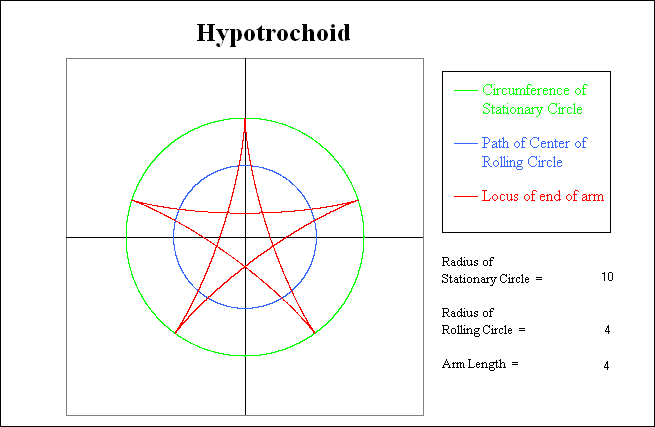
In the example shown here, the stationary circle has a radius of 10. A circle with a radius of 4 rolls around the inside of the stationary circle. Again, the dark blue circle traces the path of the center of the rolling circle. The arm length is the same as the radius of the rolling circle, and thus the end of the arm is essentially the same as a point on the rolling circle. The red line is a trace of this point, and it generates a Hypotrochoid en route as it returns to its starting location. The diagrams below illustrate various stages of this path.
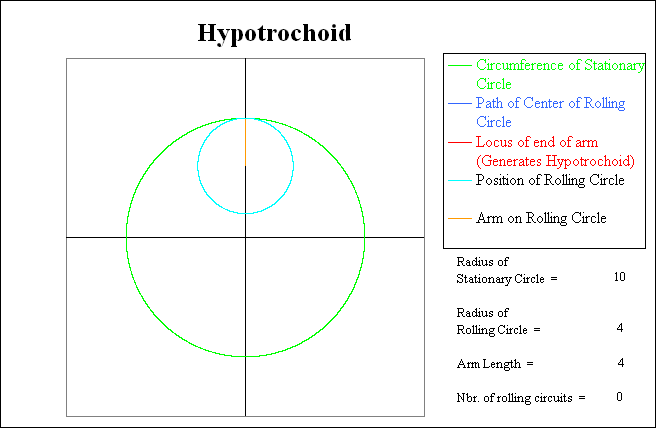
The picture above shows the starting conditions. The rolling circle is shown in light blue and the arm is again shown in orange as it overlies part of the vertical axis.
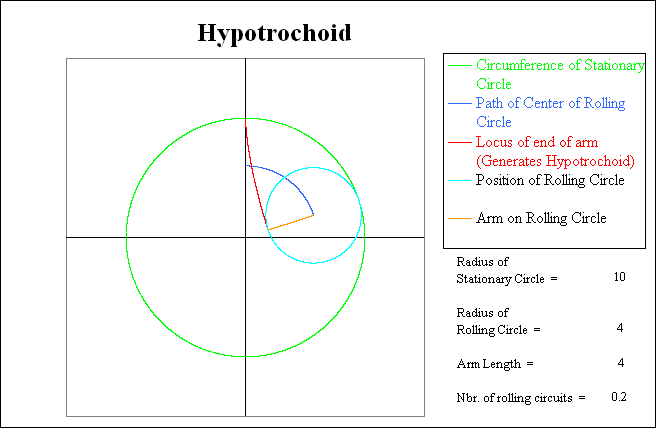
This next picture shows the interim result after the rolling circle has completed 20 % of its first circuit around the inside of the stationary circle. Note that while the rolling circle is traveling clockwise, the arm on the rolling circle is rotating counterclockwise. For each trip that the rolling circle makes around the inside of the stationary circle, the arm will make 10 / 4 = 2.5 counterclockwise revolutions relative to the stationary circle. (Count the number of arm contacts with the green circle.) However, since the relative rotation of the arm is opposite to the rolling direction of the circle, the absolute number of arm rotations as measured by the coordinate systems is one less than this: 2.5 - 1.0 = 1.5.
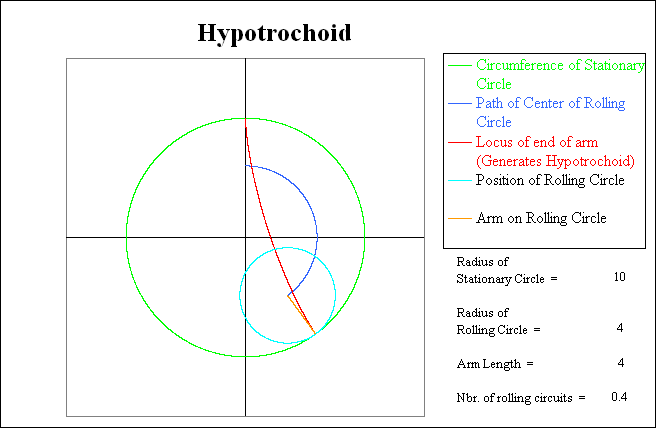
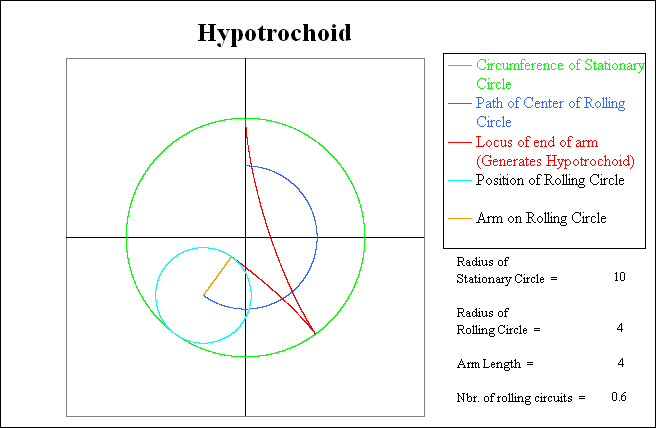
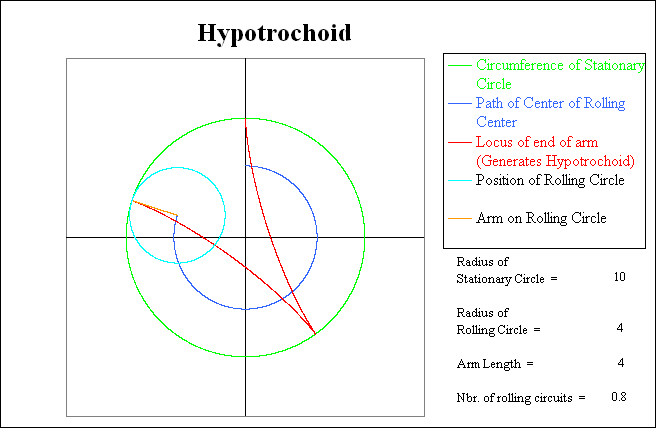
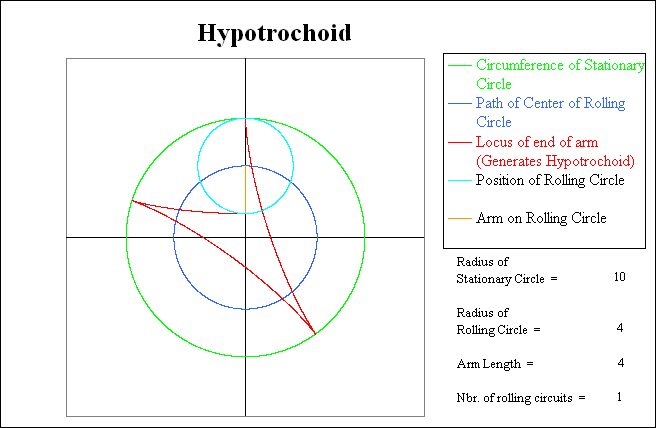
Note that when the light blue rotating circle has returned to the starting point, the red trace shows that it has gone thru 2.5 rotations relative to the green stationary circle, but has only completed 1.5 rotations relative to the coordinate system. At this point the Hypotrochoid (red line) is only one-half complete, and thus the rolling circle will have to make another circuit to complete the pattern.
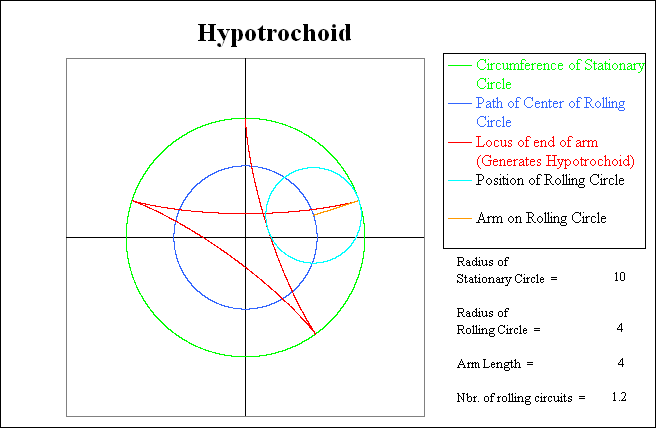
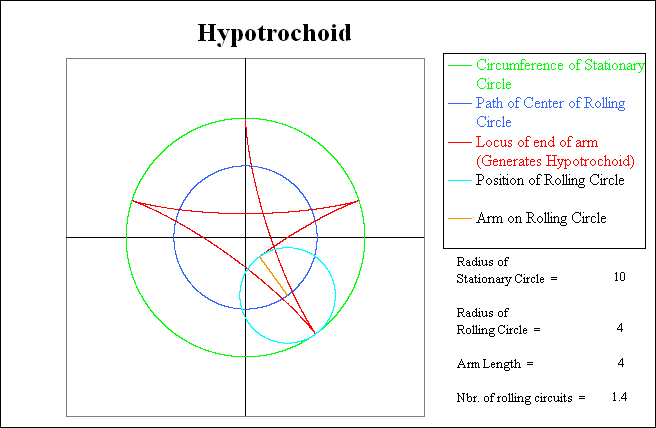
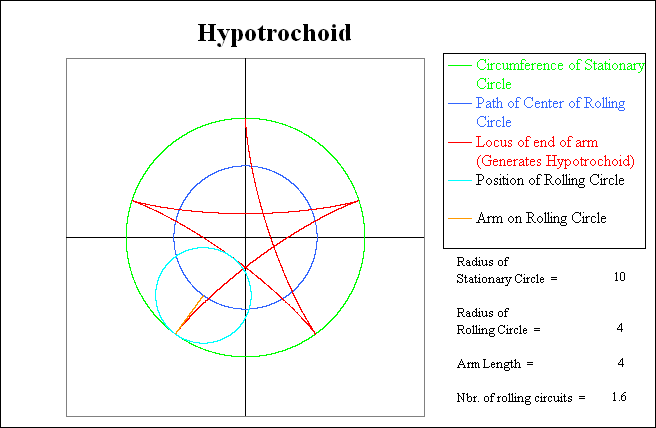
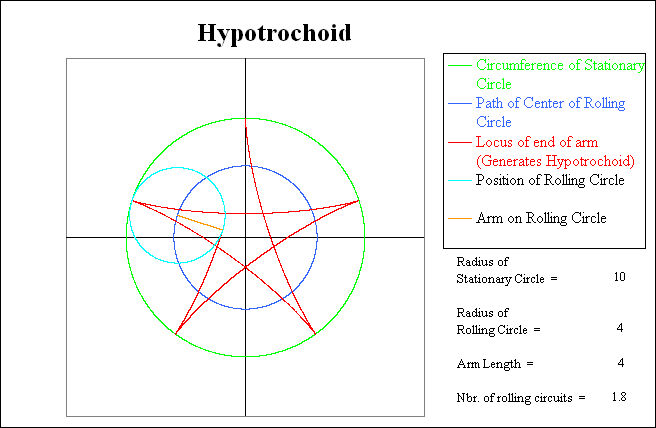
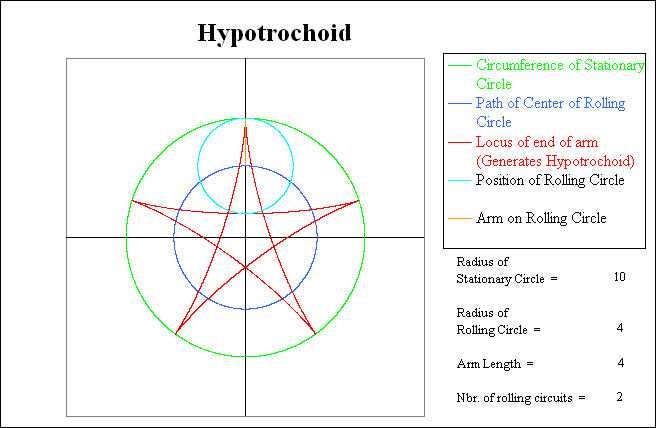
As is the case with Epitrochoids, itís interesting to experiment with various circle sizes to see what happens. One interesting phenomenon occurs when you set the radius of the rolling circle (and arm length) to 6 instead of 4. The red line traces an identical pattern, but this time it traces it backwards. Also the rolling circle has to make 3 circuits instead of two.
For additional information about Hypotrochoids and the mathematics required to generate them, please see http://mathworld.wolfram.com/Hypotrochoid.html
Return to Durango Billís main page
Web page generated via Sea Monkey's Composer HTML editor
within a Linux Cinnamon Mint 18 operating system.
(Goodbye Microsoft)